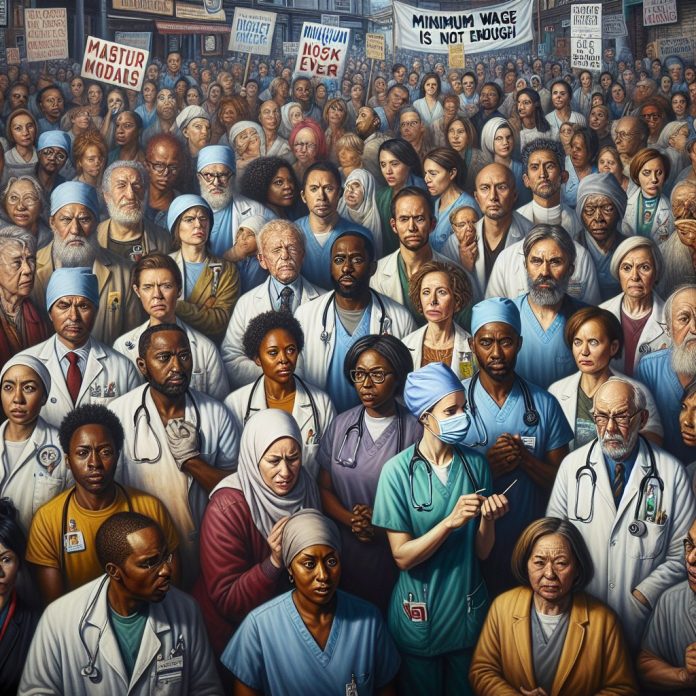
📘 Introduction to Health Care Workers Minimum Wage The topic of health care workers’ minimum wage has gained significant attention in recent years. As essential personnel on the front lines of patient care, these workers play a critical role in maintaining public health and safety. However, their compensation often does not reflect the demanding nature of their work. This article explores the current state of minimum wage for health care workers, the factors influencing it, and the implications of wage changes on the industry and society.
🏥 The Current State of Health Care Workers Minimum Wage
The minimum wage for health care workers varies widely depending on the country, state, and specific health care role. In the United States, for instance, the federal minimum wage is $7.25 per hour, but many states have implemented higher minimum wages. Health care workers, including nursing assistants, home health aides, and medical assistants, often find themselves at the lower end of the wage spectrum despite the essential nature of their work.
1. Variations in Minimum Wage by State
Different states have adopted various minimum wage standards, which can significantly affect health care workers. For example:
- California: As of January 2024, the minimum wage in California is $15.50 per hour, with plans to increase it further in the coming years.
- New York: The minimum wage varies by region, with New York City at $15.00 per hour and lower rates in upstate areas.
- Texas: Sticks to the federal minimum wage of $7.25 per hour, which is significantly lower compared to states with higher living costs.
2. Impact of Federal Minimum Wage Laws
The federal minimum wage serves as a baseline, but its adequacy is often questioned. Health care workers in states adhering strictly to the federal minimum wage may struggle with the high cost of living, leading to financial instability and job dissatisfaction.
🌟 Factors Influencing Health Care Workers Minimum Wage
Several factors influence the minimum wage for health care workers, including economic conditions, labor market dynamics, and political decisions. Understanding these factors is crucial to address the wage disparities in the health care sector.
1. Economic Conditions
The state of the economy plays a significant role in determining wages. In periods of economic growth, there is often more pressure to increase wages to attract and retain workers. Conversely, during economic downturns, wage growth may stagnate.
2. Labor Market Dynamics
The supply and demand for health care workers directly impact wages. In areas with a high demand for health care services but a limited supply of workers, wages tend to be higher. However, in regions with an oversupply of health care workers, wages can be suppressed.
3. Political Decisions
Legislative actions and political advocacy significantly impact minimum wage laws. Campaigns for a higher minimum wage, such as the “Fight for $15” movement, have gained momentum, influencing policymakers to consider raising the minimum wage to ensure a livable income for workers.
📈 Implications of Raising Health Care Workers Minimum Wage
Increasing the minimum wage for health care workers has far-reaching implications for individuals, the health care industry, and the broader economy. Here are some key considerations:
1. Improved Quality of Life for Workers
A higher minimum wage can significantly improve the quality of life for health care workers. Increased earnings can reduce financial stress, allowing workers to afford better housing, education, and health care. This can lead to increased job satisfaction and reduced turnover rates.
2. Enhanced Patient Care
Health care workers who are paid fairly are more likely to be motivated and engaged in their work. This can translate into better patient care, as workers are less likely to experience burnout and more likely to stay in their positions longer, providing continuity of care.
3. Economic Stimulus
Raising the minimum wage can stimulate the economy by increasing the purchasing power of workers. When health care workers have more disposable income, they are likely to spend more on goods and services, boosting local businesses and contributing to economic growth.
4. Challenges for Health Care Providers
While the benefits of raising the minimum wage are clear, it also presents challenges for health care providers. Increased labor costs may strain budgets, particularly for smaller health care facilities and home health care agencies. Providers may need to find ways to balance higher wages with maintaining quality care and operational efficiency.
🔍 Case Studies and Real-World Examples
Examining real-world examples can provide valuable insights into the impact of raising the minimum wage for health care workers. Here are a few notable cases:
1. California’s Wage Increase
California has been at the forefront of the movement to raise the minimum wage. The state’s gradual increase to $15.50 per hour has had mixed results. While many health care workers have benefited from higher wages, some smaller health care providers have struggled to absorb the increased labor costs. Nevertheless, the overall impact on worker satisfaction and patient care has been positive.
2. New York’s Regional Approach
New York’s approach to setting minimum wages based on regional living costs offers a more tailored solution. In New York City, the $15.00 per hour minimum wage has helped many health care workers achieve a better standard of living. However, upstate regions with lower minimum wages still face challenges in ensuring fair compensation for health care workers.
3. Washington, D.C.’s Progressive Policies
Washington, D.C. has implemented one of the highest minimum wages in the country at $16.50 per hour. This progressive approach has significantly benefited health care workers, reducing turnover and improving the quality of care. However, it also underscores the importance of balancing wage increases with the financial viability of health care providers.

🌐 The Future of Health Care Workers Minimum Wage
The future of health care workers’ minimum wage is likely to be shaped by ongoing economic, political, and social factors. Here are some trends and potential developments to watch:
1. Continued Advocacy for Higher Wages
Advocacy groups and labor unions will continue to push for higher minimum wages, particularly in states with lower wage standards. This advocacy is likely to influence legislative actions and result in incremental wage increases.
2. Increased Focus on Equity
There is a growing recognition of the need for wage equity across different regions and health care roles. Efforts to address disparities in wages for health care workers in rural and underserved areas are likely to gain momentum.
3. Technological Advancements
Technological advancements in health care may impact labor dynamics and wages. Automation and telehealth could change the demand for certain health care roles, potentially affecting wages and job security.
4. Comprehensive Health Care Reform
Comprehensive health care reform at the federal level could include provisions for minimum wage standards for health care workers. Such reforms would aim to ensure fair compensation while maintaining the sustainability of health care systems.
🌍 Conclusion
Understanding the complexities of health care workers’ minimum wage is essential for addressing wage disparities and ensuring fair compensation for these vital professionals. As the demand for health care services continues to grow, so too does the need for equitable and sustainable wage policies. By examining the factors influencing wages, the implications of wage changes, and real-world examples, stakeholders can make informed decisions that benefit health care workers, patients, and the broader economy.
Raising the minimum wage for health care workers is not just a matter of financial fairness; it is a crucial step toward improving the quality of care and supporting the well-being of those who dedicate their lives to caring for others. As society continues to value and invest in health care workers, we move closer to a more just and effective health care system for all.



















